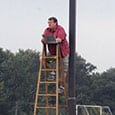I once attended a masterclass at which the person leading the session asked each player why they played their instrument. In most cases, the players replied, “Because I love the sound my instrument makes.” However, one young musician responded, “I play my instrument because I can’t sing.” After a few laughs from the audience, this led to a discussion and realization that, while the student may not have had a great voice, he could sing through his instrument.
Although I will never be a world-class singer either, I have always strived to excel in solfège classes and incorporate singing into daily practice. Not only does it help me determine how I want to phrase, but it has also helped me navigate challenging intervallic passages. Unfortunately, most of us are not encouraged to sing until we enter college and enroll in an ear-training course. Beginning band students are often hesitant to sing because they are embarrassed by the quality of their voices. This fun and constructive one-minute exercise will help students overcome their fear of singing, while also improving their ability to hear pitch.
Have the entire class form a large circle. Together as a class, sing through some major scales in unison using solfège. Moveable do is recommended so students can develop a strong sense of where the tonic pitch of a given key is. Once the students have a good grasp of how a major scale sounds and can remember the solfège syllables, assign each student a note from the same major scale. In large classes, assign multiple students to each note.
Go up and down the scale a few times, having each student or group of students sing their respective note in turn. When this has become routine, mix it up by singing scales in thirds or fourths, or sing simple folk songs. A favorite of mine is “Twinkle, Twinkle, Little Star,” sung in solfège. Students will have a good time with this activity and take pride in being responsible for their assigned note.
A variation of this exercise is to have students pass a beach ball around to one another with the person who throws the ball singing their note until the next person passes the ball on. If students can remember their respective notes, it is beneficial to explore all the intervals from the major scale. With an experienced class, teachers can move through minor, blues, and whole tone scales with a minimal amount of effort.




